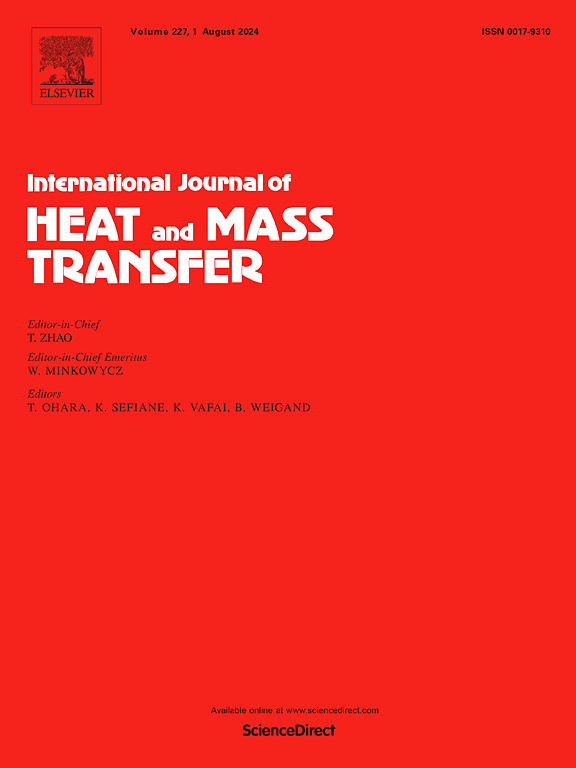Analysis of condensation heat transfer on hydrophilic-hydrophobic composite surfaces considering droplets dynamic behavior
IF 5.8
2区 工程技术
Q1 ENGINEERING, MECHANICAL
International Journal of Heat and Mass Transfer
Pub Date : 2025-05-03
DOI:10.1016/j.ijheatmasstransfer.2025.127167
引用次数: 0
Abstract
In order to reveal the enhancement effect of the hydrophilic-hydrophobic composite structure surface on condensation heat transfer and the effects of dynamic behavior characteristics of condensate droplets, an experimental system and a mathematical model of condensation on the hydrophilic-hydrophobic composite surface was established. The model is based on the theories of dropwise condensation (DWC) and filmwise condensation (FWC), in combination with the effects of droplets nucleation, coalescence, detachment, and sliding sweeping. The effects of surface structure size, wettability, operating temperature and droplet dynamic behavior on condensation efficiency were analyzed by the model. The surface has circular hydrophobic patterns with a diameter of WDWC and hydrophilic channels separated by WFWC. The results show that under the same conditions, the condensation heat transfer coefficient increases first and then decreases with the increase of WDWC, and there is only one optimal WDWC corresponding to WFWC, which maximizes the condensation heat transfer coefficient. Moreover, the optimal WDWC is only affected by WFWC and is insensitive to other factors. The average condensation heat transfer coefficient of the optimal structure size can be increased by 78.8 % and 316.6 % compared with that of the completely hydrophobic surface and hydrophilic surface. The results illustrate the possibility of enhanced condensation with composite surfaces, which provide guidance for the design and preparation of composite surfaces with hydrophobic patterns for enhanced heat transfer in steam condensation.
考虑液滴动力学行为的亲疏水复合表面冷凝传热分析
为了揭示亲疏水复合结构表面对冷凝换热的增强作用以及冷凝液滴动态行为特性的影响,建立了亲疏水复合结构表面的冷凝实验体系和数学模型。该模型基于液滴凝聚(DWC)和膜状凝聚(FWC)理论,结合液滴成核、聚并、分离和滑动扫掠的影响。通过模型分析了表面结构尺寸、润湿性、操作温度和液滴动力学行为对冷凝效率的影响。表面具有圆形疏水模式,直径为WDWC和由WFWC分隔的亲水性通道。结果表明:在相同条件下,随着水重比的增大,冷凝换热系数先增大后减小,且与水重比相对应的最优水重比只有一个,该最优水重比使冷凝换热系数达到最大;而且,最优WDWC只受WFWC的影响,对其他因素不敏感。最佳结构尺寸的平均冷凝换热系数比完全疏水表面和亲水表面分别提高78.8%和316.6%。研究结果说明了复合表面增强冷凝的可能性,为设计和制备疏水型复合表面以增强蒸汽冷凝传热提供了指导。
本文章由计算机程序翻译,如有差异,请以英文原文为准。
求助全文
约1分钟内获得全文
求助全文
来源期刊
CiteScore
10.30
自引率
13.50%
发文量
1319
审稿时长
41 days
期刊介绍:
International Journal of Heat and Mass Transfer is the vehicle for the exchange of basic ideas in heat and mass transfer between research workers and engineers throughout the world. It focuses on both analytical and experimental research, with an emphasis on contributions which increase the basic understanding of transfer processes and their application to engineering problems.
Topics include:
-New methods of measuring and/or correlating transport-property data
-Energy engineering
-Environmental applications of heat and/or mass transfer

 求助内容:
求助内容: 应助结果提醒方式:
应助结果提醒方式:


